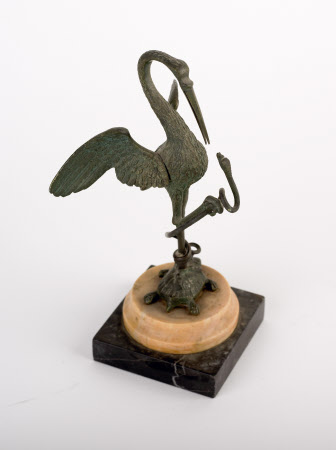Statuette of a stork, snake and turtle
Italian School
Category
Metalwork
Date
c. 1800 - 1850
Materials
Bronze, Marble
Measurements
190 x 75 mm; 75 mm (L)
Place of origin
Rome
Order this imageCollection
The Argory, County Armagh
NT 564294
Summary
Sculpture, bronze; a stork standing on a turtle, in combat with a snake; Italian, probably Rome; c. 1800-1850. A small bronze statuette, that evokes a common theme in Roman paintings and sculptures. Made for the tourist trade, the bronze was either copied from a Roman small bronze or, more probably, inspired by depictions in Roman art.
Full description
A bronze statuette depicting a stork standing on one leg, upon a small turtle. Its other leg is raised and in its claws the stork holds a snake which hisses at the bird and has coiled part of its body around the stork's stationery leg. Flapping its wings in response, the stork prepares to devour its opponent. Mounted on a circular and rectangular base made from yellow and black marble. The sight of cranes or storks grappling with snakes would have been a common one in many parts of the Roman, with images of the subject frequently found in Roman art, in fresco paintings, mosaics and in sculpture. The Sala degli Animali in the Vatican, an assemblage of Roman or later sculptures of animals, includes two in marble (Gonzalez-Palacios 2013, nos. 147 and 154), whilst there is another one in marble at Newby Hall, restored by Bartolomeo Cavaceppi and acquired in Italy around 1765 (Picon 1983, no. 21). The little bronze at the Argory may be a copy of a small Roman bronze, but it is difficult to find comparable bronzes of this type from the Roman period. It is therefore more likely to be a late eighteenth-century interpretation of this subject. An identical example was exhibited in 2018 described as Roman work, from the second half of the eighteenth century (Brun 2018, no. 90). There is another almost identical version at Belton House, on a very similar base (NT 435520). A larger bronze of an ibis, with its right leg raised and foot open, part of the assemblage of works of art in the antique style supplied by Luigi Valadier for the ‘surtout’ (centrepiece for a dining table) for Luigi Braschi Onesti, duke of Nemi, now in the Musée du Louvre, Paris, is regarded as a seventeenth-century Florentine bronze (Gonzalez-Palacios 1994, p. 162, no. 11-66). Whilst the model may date from the eighteenth century, the version at the Argory is more likely to have been cast in the early decades of the nineteenth century, when a significant number of bronzes and other works of art seem to have been acquired in Rome and brought back to Ireland to furnish the Argory. A nineteenth-century Chinese candlestick depicting a crane standing upon a tortoise is at Kedleston Hall (NT 107337). In Chinese symbolism, both animals represent long life. The version of the Argory bronze at Kedleston is also currently regarded as Chinese. Jeremy Warren November 2022
Provenance
By descent; Walter McGeough Bond (1908-86), by whom given to the National Trust in 1979.
Makers and roles
Italian School, sculptor
References
Picon 1983: Carlos Picon, Bartolomeo Cavaceppi. Eighteenth-century Restorations of ancient marble sculpture from English private collections, exh.cat. Clarendon Gallery, London 1983 Gonzalez-Palacios 1994: Alvar González-Palacios, ed., Luigi Valadier au Louvre, ou l’Antiquité exaltée, exh. cat., Musée du Louvre, Paris 1994 Gonzalez-Palacios 2013: Alvar González-Palacios, Il Serraglio di Pietra. La Sala degli Animali in Vaticano, Città del Vaticano 2013 Brun 2018: The Art of the Beast, exh. cat., Brun Fine Art, London 2018, no. 90.
